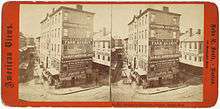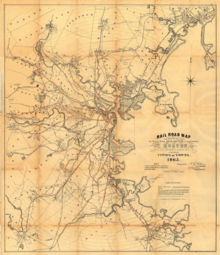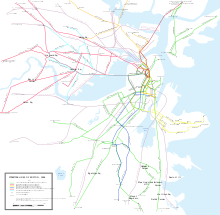Middlesex Railroad
The Middlesex Railroad (later renamed to the Boston Consolidated Street Railway) was an early street railway company that operated in the Boston, Massachusetts area in the mid-nineteenth century. It provided horsecar service for passengers traveling between Charlestown/lower Middlesex County and downtown Boston.

History


The Middlesex Railroad was founded on April 29, 1854 by an act of the Massachusetts state legislature, with Asa Fisk, Richard Downing, and David Kimball being the original corporators. The initial route proposed for the company was for a line running from one or more points in Somerville down to Charlestown Square (now City Square) in Charlestown, then continuing into Boston via the Warren Bridge and proceeding as far as Haymarket Square before returning to Charlestown via the Charles River Bridge.[1] The Somerville portion of the line went unrealized (with the rights to build in that town eventually being conveyed to the Somerville Horse Railroad),[2] but work on the Charlestown and Boston components of the route was commenced in October 1856, and on March 6 of the following year the first car was run from Charlestown Neck to the corner of Stillman and Charlestown (now North Washington) streets in Boston.[3]
In its first years the Middlesex recorded no direct passenger traffic as its road was leased to the Malden and Melrose Railroad, which furnished the equipment and handled operations.[4] Eventually, however, the Middlesex acquired a controlling interest in the Malden and Melrose, and at the end of March 1862 the latter agreed to provide the Middlesex with a forty-two year grant for exclusive use of its tracks.[5] At the same time, the company stepped into leases formerly held by the Malden and Melrose, by which it additionally gained control of the lines of the Medford and Charlestown, the Somerville Horse, and the Boston and Chelsea railroads.[6] Use of the Boston and Chelsea was soon however transferred to the Lynn and Boston Railroad, while operation of the Somerville Horse was eventually divided with the Union Railroad.[7]
By the mid-1860s the Middlesex constituted one of the four principal street railways of the Boston area, together with the Metropolitan, Union/Cambridge, and South Boston.[8] In 1865 the company reported an annual passenger count of 2.8 million (excluding passengers counted by lessor lines), which increased to 4.4 million by 1875 and 7.6 million in 1885.[9]
In 1870 the Middlesex consolidated with the Suburban Railroad Company, and a decade later it did the same with the Medford and Charlestown.[10] The lease for the Somerville Horse, meanwhile, was assigned to the Union in 1876.[11]
In August 1886 the Middlesex and the Highland Street Railway agreed to consolidate and form the Boston Consolidated Street Railway, with Charles Edward Powers of the Middlesex serving as president and Moody Merrill of the Highland as vice president.[12] With the merger, the new company became the second largest street railway operating in Boston (after the Metropolitan), and the addition of the Highland lines extended operations southward into the neighborhoods of the South End and Dorchester.[13]
In 1887 the West End Street Railway gained a controlling interest in the Boston Consolidated as part of its general plan to unite the public streetcars of Boston under one company. The railroad was formally merged into the West End on November 12 of that year.[14]
Notes
- Massachusetts General Court 1854, p. 335; Hager 1892, p. 16.
- Samuels & Kimball 1897, p. 471; Briggs 1887, p. 889.
- Hager 1892, p. 166.
- Warner 1862, "Middlesex" p. 4.
- Swift 1909, pp. 300, 303.
- Warner 1863, "Horse Railroad Companies" Abstract.
- Warner 1864, p. 370; Warner 1865, p. 330; Warner 1866, p. 290.
- Pinanski 1908, pp. 10-11; Fifty Years 1938, p. 13.
- Warner 1866, p. 314; Massachusetts Board of Railroad Commissioners 1876, p. 200; Massachusetts Board of Railroad Commissioners 1886, p. 179.
- Public Service Commission 1915, p. 938.
- Northeastern Reporter 1888, p. 67; Massachusetts Board of Railroad Commissioners 1877, p. 449.
- Boston Daily Globe 1886, p. 3; Public Service Commission 1915, p. 938.
- Massachusetts Board of Railroad Commissioners 1888, p. 252; Hager 1892, p. 20.
- Pinanski 1908, pp. 17-18; Public Service Commission 1915, p. 939.
References
- "An Act To Incorporate The Middlesex Railroad Company". Act No. Chap. 0434 of 1854. Massachusetts General Court.
- "They Vote to Consolidate". Boston Daily Globe. August 20, 1886. Retrieved December 30, 2019.
- Briggs, James E., ed. (1887). New England Reporter: All Cases Determined in the Courts of Last Resort. IV. Rochester, NY: The Lawyers' Co-Operative Publishing.CS1 maint: ref=harv (link)
- Fifty Years of Unified Transportation in Metropolitan Boston. Boston: Boston Elevated Railway Company. 1938.
- Hager, Louis P., ed. (1892). History of the West End Street Railway. Boston: Louis P. Hager.CS1 maint: ref=harv (link)
- Massachusetts Board of Railroad Commissioners (1876). Seventh Annual Report of the Board of Railroad Commissioners, January 1876. Boston: Wright & Potter.CS1 maint: ref=harv (link)
- Massachusetts Board of Railroad Commissioners (1877). Eighth Annual Report of the Board of Railroad Commissioners, January 1877. Boston: Albert J. Wright.CS1 maint: ref=harv (link)
- Massachusetts Board of Railroad Commissioners (1886). Seventeenth Annual Report of the Board of Railroad Commissioners, January 1886. Boston: Wright & Potter.CS1 maint: ref=harv (link)
- Massachusetts Board of Railroad Commissioners (1888). Nineteenth Annual Report of the Board of Railroad Commissioners, January 1888. Boston: Wright & Potter.CS1 maint: ref=harv (link)
- The Northeastern Reporter, Containing All of the Current Decisions of the Supreme Courts of Massachusetts, Ohio, Indiana, Illinois, and the Court of Appeals of New York, October 14-December 23,1887. 13. Saint Paul: West Publishing. 1915.
- Pinanski, Abraham Edward (1908). The Street Railway System of Metropolitan Boston. New York: McGraw Publishing.CS1 maint: ref=harv (link)
- Second Annual Report of the Public Service Commission. 2. Boston: Wright & Potter. 1915.
- Samuels, Edward A.; Kimball, Henry H., eds. (1897). Somerville, Past and Present: An Illustrated Historical Souvenir. Boston: Samuels & Kimball.CS1 maint: ref=harv (link)
- Swift, Henry Walton (1909). Massachusetts Reports: Cases Argued and Determined in the Supreme Judicial Court of Massachusetts, May 1909-June 1909. 202. Boston: Little, Brown & Company.CS1 maint: ref=harv (link)
- Warner, Oliver (1862). Returns of the Railroad Corporations of Massachusetts, 1861: With Abstracts of the Same. Boston: Wright & Potter.CS1 maint: ref=harv (link)
- Warner, Oliver (1863). Returns of the Railroad Corporations of Massachusetts, 1862: With Abstracts of the Same. Boston: Wright & Potter.CS1 maint: ref=harv (link)
- Warner, Oliver (1864). Returns of the Railroad Corporations of Massachusetts, 1863: With Abstracts of the Same. Boston: Wright & Potter.CS1 maint: ref=harv (link)
- Warner, Oliver (1865). Returns of the Railroad Corporations of Massachusetts, 1864: With Abstracts of the Same. Boston: Wright & Potter.CS1 maint: ref=harv (link)
- Warner, Oliver (1866). Returns of the Railroad Corporations of Massachusetts, 1865: With Abstracts of the Same. Boston: Wright & Potter.CS1 maint: ref=harv (link)